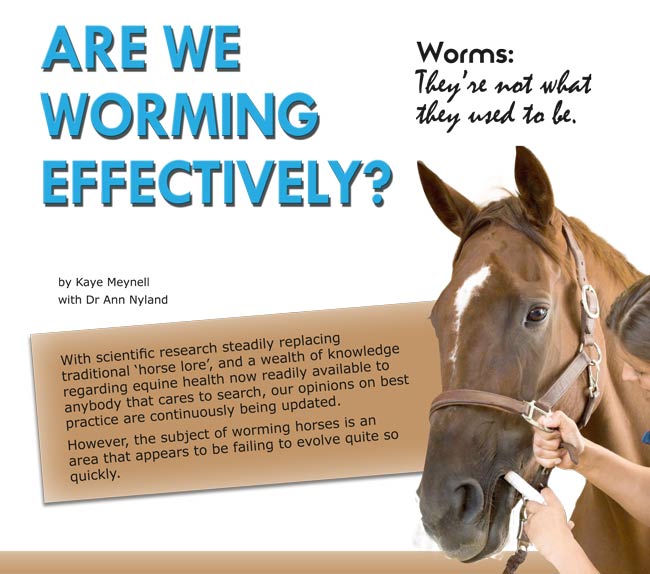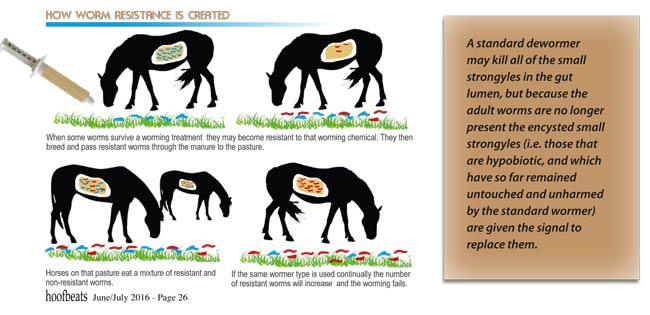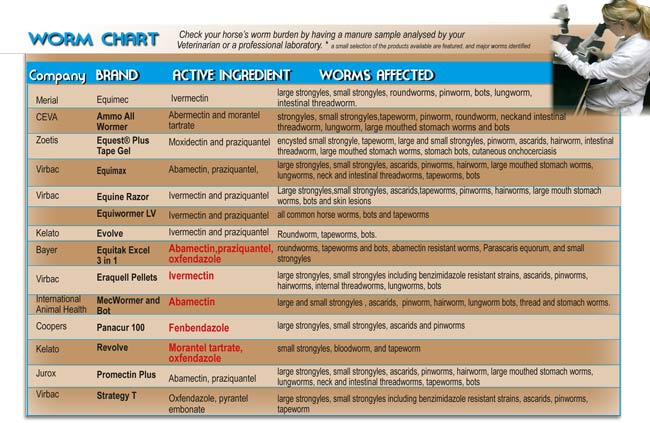|
THE WORM HAS TURNED

PLEASE NOTE:
The text in the table in the printed magazine has slipped, causing the ingredients to be against the wrong products- THE CORRECTED CHART IS BELOW.
Whilst our knowledge of what worms currently pose a risk to today’s horse has advanced, it appears that some in the industry continue to recommend worming regimes that are based on knowledge and concepts that are some 30 or 40 years old.
“The whole worming scene has changed dramatically in the last two decades,” comments Dr Ann Nyland. “Worming treatments for adult horses (i.e. those over the age of 3) in the 1980’s and ‘90s targeted the large strongyle, of which there are three (Strongylus vulgaris – aka the Bloodworm, S edentatus, and S equinus), since these were the worms commonly causing problems in adult horses during that time.
Today, the current dangerous worm is the small strongyle, or cyathostome (of which there are over 40 species, with a subset of around 10 being the most prolific), however the majority of advice given today for worming horses is still aimed at the old regime suited to eradicating the large strongyle…which is no longer a problem!”
For example, the old idea of rotation still lingers on from the early days, when it was first put forward in 1966, comments Dr Nyland. “A lot has changed since 1966 and many equine parasitologists no longer advocate rotation. In fact, misinformation about donkey and horse worms is prolific on the Internet, both from natural therapists and from companies that manufacture anthelmintic chemicals – some of whom still recommend interval drenching and rotation.”

LIFE CYCLE
Before discussing the treatment options for small strongyle worm burdens in horses, one needs to consider the life cycle of the cyathostome says Dr Nyland.
L1 - Larvae
“The adults lay eggs, which are passed in the horse’s droppings. Favourable conditions are humidity (approx. 80%) and an optimum temperature of 25°C; under these conditions the eggs passed in the manure will develop into L1 larvae within a few days. With temperatures averaging 12°C it could take weeks or months for an egg to progress through to the L3 infective stage in the manure. Note that no successful larval development takes place in temperatures less than 5°C or more than 38°C (larvae start to die at temperatures over 32°C, though they can tolerate a heavy frost or freezing). The horse eats the L3 and these go into the lining of the colon – sometimes as quickly as within six hours!”
EL3s - Early Larvae Once they enter this tissue in the body they become known as ‘Early L3 Larvae’ (or EL3s). These EL3s form a cyst and within this cyst can either continue to mature and progress immediately to a fourth stage larva (L4) in the mucosa, or they might arrest their own development by becoming hypobiotic and can remain this way for anything from a few months to a few years. “In the northern hemisphere, in northern temperature climates, this happens in winter simply because it is too cold for larval development. In the southern temperate climates, with hot summers and mild winters, this happens in the summer so they avoid being killed by a hot summer sun.”
Dr Nyland goes on to comment that currently there is no product on the market that is 100% effective against all worms.
“Only moxidectin (as a single dose) and fenbendazole (for 5 consecutive days) are effective against some stages of encysted cyathostomes. Moxidectin might not kill all EL3s in one dose. The registered claim of Equest shows it is currently the only wormer effective as a single dose against encysted stages of small strongyles, developing stages, late encysted stages, and aids in the control of early encysted stages including inhibited larvae (it is approximately 90% effective). Fenbendazole (though note that some resistance has been demonstrated) has been shown to be effective against inhibited EL3 if given for 5 consecutive days (this would be off-label in Australia), at a dose of 10mg/kgBW (which is the recommended dose for Panacur here in Australia, but is actually double the dose recommended in other countries)! No wormer other than moxidectin at a single dose, or fenbendazole for 5 consecutive days at the dose described above, has any effect whatsoever on these encysted small strongyles.”

PLEASE NOTE- the above chart is a correction to the one printed in the June July issue
EXTRACT - To read the complete article in the June July 16 issue.
Purchase an App 
or purchase the current print magazine
|